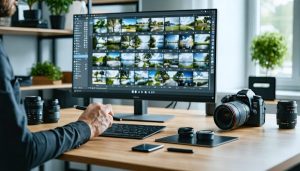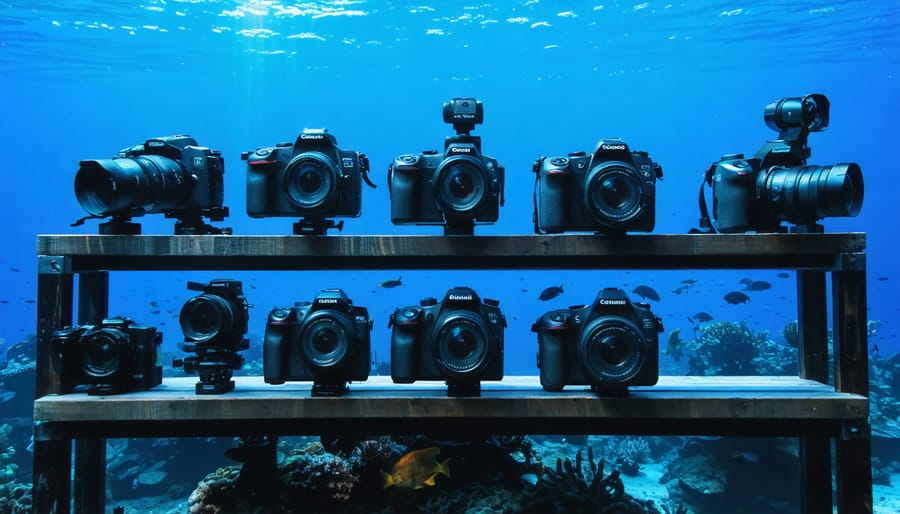
Capturing the mesmerizing underwater world demands specialized equipment that protects your camera while delivering professional-quality images. Before diving into underwater photography basics, selecting the right gear can mean the difference between stunning shots and costly mistakes. From entry-level waterproof cameras to professional DSLR housings, today’s underwater photography equipment offers solutions for every budget and skill level.
Modern underwater gear has transformed what’s possible beneath the waves, enabling photographers to capture everything from coral reef macro shots to wide-angle whale encounters. Whether you’re shooting in shallow tropical waters or exploring deep-sea environments, understanding your equipment options is crucial for success. This guide breaks down essential underwater photography gear—from cameras and housings to strobes and accessories—helping you make informed decisions that align with your photography goals and diving experience.
Remember: Even the most sophisticated underwater camera system is only as good as your understanding of how to use it effectively. Let’s explore the gear that will help you create compelling underwater images while keeping your equipment safe in challenging marine environments.
Underwater Camera Housing Systems
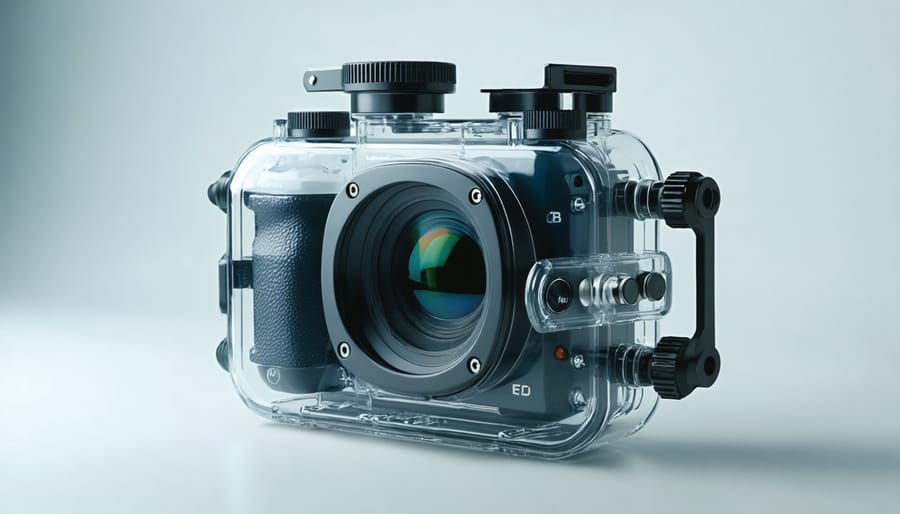
Hard Cases vs. Soft Pouches
When it comes to protecting your camera underwater, you’ll typically choose between hard cases and soft pouches, each offering distinct advantages and trade-offs. Hard cases, constructed from durable polycarbonate or aluminum, provide maximum protection and reliable waterproofing down to significant depths. They offer precise control access through dedicated buttons and dials, making them ideal for serious underwater photography. These cases also maintain consistent pressure and can accommodate additional ports for different lenses.
However, hard cases come with considerable drawbacks. They’re typically expensive, with professional models costing more than the cameras themselves. They’re also bulky, heavy, and specific to your camera model, meaning you’ll need a new case if you upgrade your gear.
Soft pouches, on the other hand, are more affordable and versatile. These flexible, transparent housings work with various camera models and are perfect for shallow water photography, snorkeling, or beach activities. They’re lightweight, packable, and ideal for travel. Many photographers start with soft pouches to test the waters of underwater photography before investing in more serious equipment.
The main limitations of soft pouches include restricted depth ratings (usually up to 15-20 feet), less precise control access, and potential issues with image quality due to the flexible material. They also require careful handling to prevent leaks and may not last as long as hard cases.
Choose based on your needs: hard cases for serious underwater work and deeper diving, soft pouches for casual use and travel convenience. Consider your budget, intended use, and comfort level when making this important decision.
Depth Ratings and Construction
When selecting underwater photography equipment, understanding depth ratings and construction materials is crucial for both safety and performance. Most recreational underwater housings are rated for depths between 30-60 meters (100-200 feet), which is suitable for most scuba diving photography. Professional-grade housings can reach depths of 100 meters (330 feet) or more, though these come with a significant price increase.
Housing materials typically fall into three categories: polycarbonate, aluminum, and machined aluminum. Polycarbonate housings are lightweight, cost-effective, and perfect for shallow water and casual use, making them popular among beginners. However, they may have lower depth ratings and are more prone to scratches.
Aluminum housings offer superior durability and better depth ratings. Their robust construction provides excellent protection for your camera and usually features more sophisticated control systems. While heavier than polycarbonate, they’re less susceptible to damage and often preferred by serious photographers.
Machined aluminum housings represent the premium tier, offering the highest depth ratings and ultimate durability. These housings are typically custom-made for specific camera models, ensuring perfect fit and functionality. They also feature advanced sealing systems with double O-rings and vacuum testing capabilities.
Pay special attention to the housing’s sealing mechanism. Quality housings use precision-engineered O-rings and locking systems to prevent water ingress. Many modern housings include moisture detectors that alert you to potential leaks before water damage occurs. Regular maintenance of these sealing components is essential, including cleaning O-rings and checking for damage before every dive.
Remember that deeper diving requires more robust construction not just for water pressure resistance, but also to maintain precise control operation at depth.
Lighting Equipment for the Deep
Strobes and Flash Systems
Lighting is crucial in underwater photography, and while natural light can be beautiful, it’s often insufficient below certain depths. This is where strobes and flash systems become essential tools for mastering lighting techniques in underwater environments.
The two main types of underwater lighting systems are strobes (flash units) and continuous lighting. Strobes provide powerful bursts of light ideal for freezing motion and capturing vibrant colors, while continuous lights offer constant illumination that’s particularly useful for video work and composition setup.
For beginners, single-strobe setups are often sufficient. These typically mount on an adjustable arm attached to your housing, allowing you to position the light precisely where needed. More advanced photographers often opt for dual-strobe systems, which provide more even illumination and help eliminate harsh shadows.
Modern underwater strobes come with various features worth considering:
– TTL (Through The Lens) capability for automatic flash exposure
– Manual power adjustment for precise control
– Variable beam angles to match different shooting situations
– Fast recycle times for capturing quick-moving subjects
– Emergency backup modes if primary systems fail
When choosing a strobe system, consider the guide number (GN), which indicates the unit’s power output. Larger numbers mean more powerful lights, but remember that bigger isn’t always better – matching the strobe to your typical shooting distance and subjects is more important than raw power.
For macro photography, smaller strobes with good close-focus capabilities work well. Wide-angle photography typically requires more powerful units with broader beam angles. Some photographers combine both types for maximum versatility.
Most quality underwater strobes are neutrally buoyant, which makes them easier to handle underwater. They also feature temperature and depth sensors to prevent overheating and ensure safe operation at various depths.
Remember to budget for essential accessories like arms, clamps, and sync cords, as these components are crucial for achieving optimal lighting positions and reliable operation.
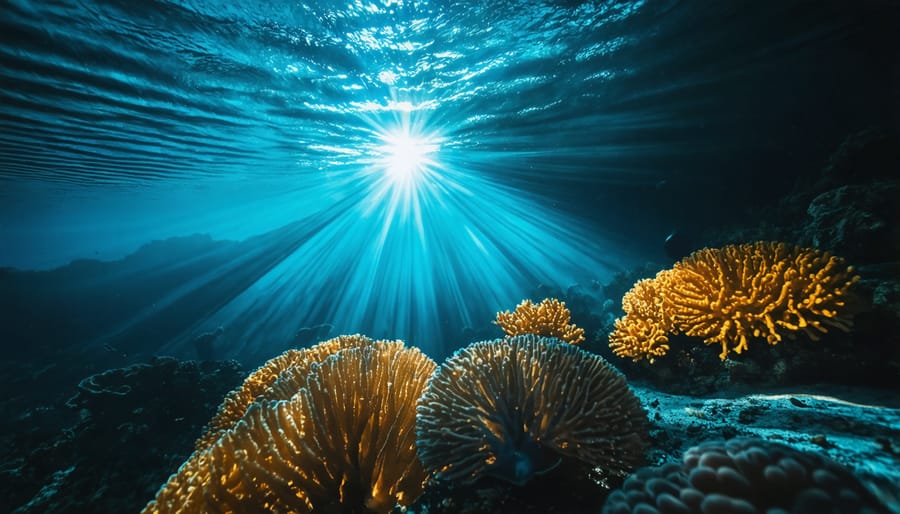
Continuous Lighting Options
While strobes are excellent for capturing fast-moving subjects, continuous lighting offers unique advantages for underwater photography. Video lights, originally designed for underwater videography, have become increasingly popular among still photographers thanks to their versatility and ease of use.
Modern LED video lights provide powerful, constant illumination that lets you see exactly how your subject will be lit before taking the shot. This real-time preview is particularly helpful when photographing stationary subjects like coral formations or slow-moving marine life. Unlike strobes, video lights also allow you to focus more easily in low-light conditions, making them ideal for night dives or exploring deeper waters.
These lights typically offer adjustable power settings and color temperatures, giving you precise control over your lighting. Many models feature a wide beam angle (usually 90-120 degrees) that provides even coverage for close-up and macro photography. Some advanced units even include red light modes, which are less likely to disturb marine life and can help you approach shy creatures more successfully.
However, continuous lights do have their limitations. They generally don’t produce the same power output as strobes, which means you’ll need to work at closer distances or use higher ISO settings. Battery life can also be a concern since the lights are constantly running. Most photographers can expect 45-90 minutes of use at full power, though this varies significantly between models.
For the best results, consider using video lights as part of a hybrid lighting setup. They work exceptionally well as focus lights or for adding fill light when using strobes as your main light source. When choosing video lights, look for models with at least 1000-2000 lumens for basic photography, though professional photographers might want to consider more powerful options in the 3000-6000 lumen range.
Remember to factor in depth rating and build quality when selecting your lights, as these directly impact where and how you can use them in your underwater photography adventures.
Essential Accessories
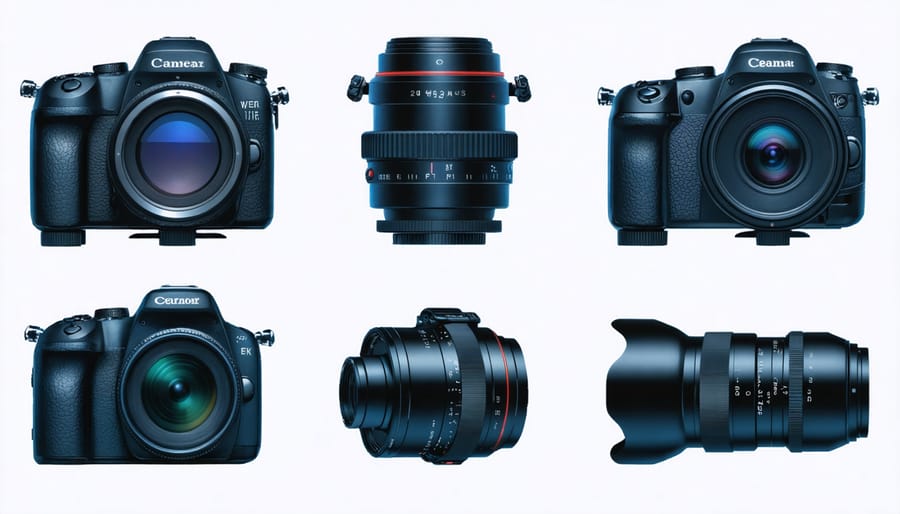
Ports and Lenses
Ports and lenses are crucial components that determine the quality and versatility of your underwater photography setup. Dome ports are the most common choice for wide-angle photography, allowing you to capture expansive reef scenes and large marine life. These ports help maintain image quality by correcting for underwater refraction and minimizing distortion. Available in both acrylic and glass versions, glass dome ports typically offer superior optical quality but come at a higher price point and weight.
Flat ports, on the other hand, excel at macro photography techniques and close-up shots of smaller subjects. They’re ideal for photographing nudibranchs, shrimp, and coral details. While flat ports are more affordable and compact, they reduce the field of view of your lens underwater by about 25% due to refraction.
When selecting lenses for underwater use, consider that wide-angle zooms (like 16-35mm) and fisheye lenses work exceptionally well with dome ports. For macro work, prime lenses in the 60mm to 105mm range paired with flat ports deliver stunning results. Remember that your lens choice should match your port type – using the wrong combination can result in soft images or severe vignetting.
Many photographers find success starting with a versatile setup: a medium-sized dome port for wide-angle work and a flat port for macro shots. This combination covers most underwater photography scenarios while keeping the gear investment reasonable. As you develop your style, you can expand your port and lens collection to match your specific shooting preferences.
Arms and Mounting Systems
Arms and mounting systems are crucial for achieving stable, well-composed underwater shots. These systems help you position your camera and lighting equipment precisely while maintaining buoyancy and maneuverability underwater.
The most basic mounting system is a single tray with one or two handles, which provides stability and attachment points for strobes or video lights. For more complex setups, dual-handle trays offer enhanced control and multiple mounting points for accessories. These systems typically feature adjustable arms made from aluminum or carbon fiber, connected by ball joints that allow for precise positioning.
Flex arms are popular among beginners for their simplicity and affordability. While they’re easy to adjust underwater, they may not hold position as firmly as ball-joint systems when supporting heavier equipment. Ball-joint arms, though more expensive, offer superior stability and precise control. These typically consist of multiple segments connected by clamps that can be loosened or tightened underwater.
When choosing an arms system, consider the weight and bulk of your camera setup. Compact cameras might only need a simple single-arm configuration, while professional DSLR rigs often require multiple arms to support strobes, focus lights, and other accessories. The length of your arms is also important – longer arms provide more positioning options but can become unwieldy in strong currents.
Remember to maintain your mounting system regularly, as salt water can affect the smoothness of ball joints and clamps. A quick freshwater rinse after each dive and occasional lubrication of moving parts will keep your system operating smoothly.
Maintenance Tools
Proper maintenance of your underwater photography gear isn’t just about preserving your investment – it’s essential for reliable performance and preventing equipment failures during precious dive moments. A well-organized maintenance kit should include several key tools.
First and foremost, keep a selection of silicone grease and O-ring lubricants specifically designed for underwater equipment. These are crucial for maintaining watertight seals on housing components. Include a set of O-ring removal tools to safely extract and replace these vital seals without damaging them.
A comprehensive cleaning kit is essential, consisting of lint-free microfiber cloths, lens cleaning solution, and a soft-bristled brush for removing salt deposits and debris. Many photographers also keep a supply of moisture-absorbing silica gel packets to prevent condensation inside housings.
For routine maintenance, you’ll need precision screwdrivers in various sizes, along with housing-specific tools that may have come with your equipment. A UV flashlight can be invaluable for detecting hairline cracks or seal compromises in housings, while a vacuum pump tester helps verify the integrity of your housing’s seals before diving.
Keep a repair kit containing spare O-rings, housing screws, and other small parts specific to your gear. Having these tools readily available in a waterproof case ensures you can perform regular maintenance and address minor issues before they become major problems underwater.
Practical Considerations
Budget vs. Professional Setups
When diving into underwater photography, the choice between budget and professional setups often comes down to your commitment level and shooting goals. Entry-level setups, typically ranging from $500-1,500, usually include a compact camera, basic housing, and a starter strobe. While these won’t deliver National Geographic-worthy shots, they’re perfect for learning expert underwater photography tips without breaking the bank.
Mid-range setups ($2,000-5,000) offer significantly better image quality and durability. You’ll get a mirrorless camera or entry-level DSLR, quality housing, dual strobes, and better lens options. This tier represents the sweet spot for serious enthusiasts, offering professional-grade features without the eye-watering price tag of top-tier gear.
Professional setups ($6,000+) include full-frame cameras, premium housings, multiple strobes, and specialized lenses. While these deliver outstanding image quality and durability, they require substantial investment and expertise. Consider that higher-end equipment often holds its value better and provides room for growth, but it won’t automatically make you a better photographer.
Remember that additional costs like maintenance, travel cases, and backup equipment should factor into your budget planning. Starting modest and upgrading as your skills improve often makes more sense than diving straight into professional gear.
Travel-Friendly Options
When packing for underwater photography adventures, size and weight considerations become crucial. Fortunately, modern equipment offers several compact solutions that don’t compromise on quality. Lightweight housings made from durable polycarbonate materials provide excellent protection while keeping your gear portable. Many manufacturers now offer travel-specific underwater housing systems that break down into smaller components for easier packing.
For those seeking ultimate portability, mobile underwater photography options have evolved significantly, with specialized cases for smartphones delivering impressive results. Compact mirrorless cameras paired with mini dome ports offer an excellent balance between image quality and portability.
Consider investing in neoprene protective sleeves for your equipment, which provide cushioning without taking up much space. Collapsible lighting systems, such as travel strobes with folding arms, can reduce your kit size by up to 50%. Multi-purpose accessories like convertible macro/wide-angle wet lenses eliminate the need for carrying multiple pieces of gear.
Remember to pack essential maintenance tools and spare O-rings in a small, waterproof container. This travel-ready approach ensures you’re well-equipped for underwater photography while maintaining mobility and convenience.
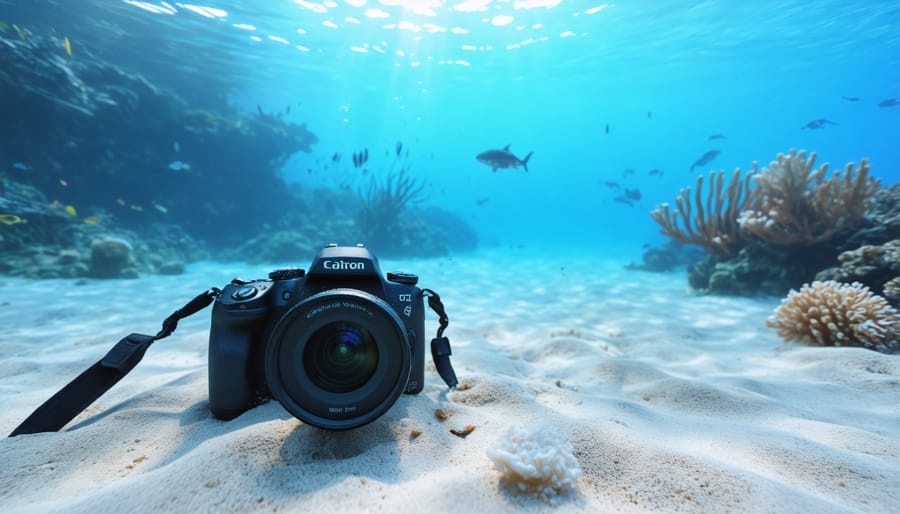
Underwater photography opens up a fascinating world of creative possibilities, but success depends heavily on choosing the right equipment for your needs and skill level. Whether you’re starting with a basic waterproof camera or investing in a professional DSLR housing system, remember that quality and reliability should be your top priorities when selecting gear for underwater use.
For beginners, we recommend starting with a compact camera and housing combination, allowing you to learn the basics while minimizing initial investment. As your skills progress, consider upgrading to more advanced strobes and lenses that will help you capture the vibrant colors and unique perspectives that underwater photography offers.
Remember to properly maintain your equipment, regularly check seals and O-rings, and always test new gear in controlled conditions before taking it into open water. While budget considerations are important, investing in quality equipment will ultimately save you money and provide better results in the long run.
Most importantly, take time to learn and practice with your chosen equipment. The best underwater photos come from photographers who thoroughly understand their gear and how to use it effectively in challenging aquatic environments.





















